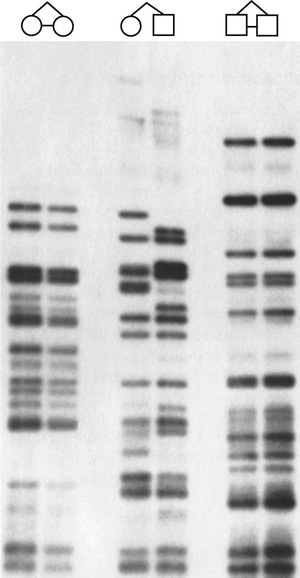Another approach is to compare the disease relative risk ratio in biological relatives of the proband with that in biologically unrelated family members (e.g., adoptees or spouses), all living in the same household environment. Returning to MS, for example, λr is 190 for MZ twins and 20 to 40 for first-degree biological relatives (parents, children, and sibs). In contrast, λr is 1 for the adopted siblings of an affected individual, suggesting that most of the familial aggregation in MS is genetic rather than the result of a shared environment. A similar analysis can be carried out for quantitative traits such as blood pressure: no correlation exists between a child’s blood pressure and that of his adopted siblings, in contrast to the positive correlation with blood pressure of biological siblings, all living in the same household.
Distinguishing between Genetic and Environmental Influences Using Twin Studies
Of all methods used to separate genetic and environmental influences, geneticists have relied most heavily on twin studies.
Twinning
MZ and DZ twins are “experiments of nature” that provide an excellent opportunity to separate environmental and genetic influences on phenotypes in humans. MZ twins arise from the cleavage of a single fertilized zygote into two separate zygotes early in embryogenesis (see Chapter 14). They occur in approximately 0.3% of all births, without significant differences among different ethnic groups. At the time the zygote cleaves in two, MZ twins start out with identical genotypes at every locus and are therefore often thought of as having identical genotypes and gene expression patterns.
In contrast, DZ twins arise from the simultaneous fertilization of two eggs by two sperm; genetically, DZ twins are siblings who share a womb and, like all siblings, share, on average, 50% of the alleles at all loci. DZ twins are of the same sex half the time and of opposite sex the other half. In contrast to MZ twins, DZ twins occur with a frequency that varies as much as fivefold in different populations, from a low of 0.2% among Asians to more than 1% of births in parts of Africa and among African Americans.
The striking difference between MZ and DZ twins in their genetic makeup is most easily seen by comparing the pattern for a type of so-called DNA fingerprint in twins (Fig. 8-4). This method of DNA fingerprinting is generated by simultaneously examining many DNA fragments of varying lengths that share a particular DNA sequence (minisatellite) and are located throughout the genome. MZ twins show an indistinguishable pattern, whereas many differences are seen between DZ twins, whether of same sex or not.

Disease Concordance in Monozygotic and Dizygotic Twins
When twins have the same disease, they are said to be concordant for that disorder. Conversely, when only one member of the pair of twins is affected and the other is not, the relatives are discordant for the disease. An examination of how frequently MZ twins are concordant for a disease is a powerful method for determining whether genotype alone is sufficient to produce a particular disease. The differences between a disease that is mendelian from one that shows complex inheritance are immediately evident. Using sickle cell disease (Case 42) as an example of a mendelian disorder, if one MZ twin has sickle cell disease, the other twin will always have the disease as well. In contrast, as an example of a multifactorial disorder, when one MZ twin has type 1 diabetes mellitus (previously known as insulin-dependent or juvenile diabetes) (Case 26), the other twin will also have type 1 diabetes in only approximately 40% of such twin pairs. Disease concordance less than 100% in MZ twins is strong evidence that nongenetic factors play a role in the disease. Such factors could include environmental influences, such as exposure to infection or diet, as well as other effects, such as somatic mutation, effects of aging, or epigenetic changes in gene expression in one twin compared with the other.
MZ and same-sex DZ twins share a common intrauterine environment and sex and are usually reared together in the same household by the same parents. Thus a comparison of concordance for a disease between MZ and same-sex DZ twins shows how frequently disease occurs when relatives who experience the same prenatal and often the same postnatal environment have the same alleles at every locus (MZ twins), compared with only 50% of their alleles in common (DZ twins). Greater concordance in MZ versus DZ twins is strong evidence of a genetic component to the disease, as shown in Table 8-4 for a number of disorders.
TABLE 8-4
Concordance Rates in MZ and DZ Twins for Various Multifactorial Disorders
| Concordance (%)* | ||
| Disorder | MZ | DZ |
| Nontraumatic epilepsy | 70 | 6 |
| Multiple sclerosis | 18 | 2 |
| Type 1 diabetes | 40 | 5 |
| Schizophrenia | 46 | 15 |
| Bipolar disease | 62 | 8 |
| Osteoarthritis | 32 | 16 |
| Rheumatoid arthritis | 12 | 3 |
| Psoriasis | 72 | 15 |
| Cleft lip with or without cleft palate | 30 | 2 |
| Systemic lupus erythematosus | 22 | 0 |
